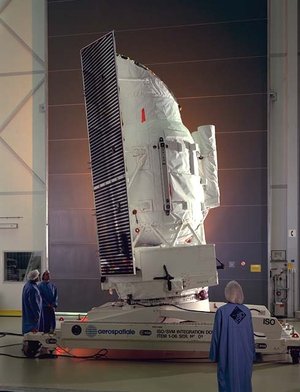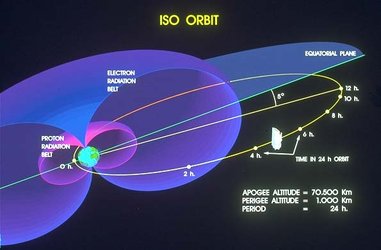Infrared anniversary
This week saw the ninth anniversary of the launch of ESA's Infrared Space Observatory (ISO) mission.
ISO was launched on 17 November 1995 by an Ariane 44P launcher from Europe's spaceport in Kourou, French Guiana.
Probing the cool and hidden Universe, ISO was the most sensitive infrared satellite ever launched. It made particularly important studies of the dusty regions of the Universe, where visible light telescopes can see nothing.

The wealth of data collected by ISO still produces important science results.
Infrared radiation is primarily 'heat', or thermal radiation. Even objects that we think of as being very cold, such as an ice cube, emit infrared radiation.
Observing astronomical objects in the infrared means that we can see much more than we can with optical telescopes.
Europe’s first venue into infrared astronomy had been the US–Dutch–British IRAS satellite launched in 1983. This mission mapped 250 000 cosmic infrared sources and large areas of extended emission.

The IRAS mission was so successful that, once it was over, ESA decided that it was important to continue observing in the infrared. The ISO project was started by ESA under its Horizon 2000 science programme.
ISO provided astronomers with a unique facility to see both familiar objects in an unusual way and objects that are invisible at other wavelengths. Its detectors, with an enhanced sensitivity and resolution, allowed a much closer and more detailed perception of the 'infrared scenery'.
The scientific instruments were provided separately by a group of eleven European countries. The United States and Japan co-operated on ground support operations in return for average daily observing time of half an hour each.

Observing the cool Universe requires cooled instruments which can work at temperatures close to absolute zero, –273°C.
Keeping the temperature this low was the task of the large liquid-helium cryostat on board ISO, filled before launch with 2286 litres of superfluid helium.
This cryostat made ISO one of the coldest objects in the Universe. ISO’s lifetime was limited by its helium supply, so nearly all observations had to stop when this coolant liquid was depleted on 8 April 1998.
Initially ISO was supposed to be operational for 18 months, but thanks to meticulous engineering and some good fortune, the satellite's working life was stretched to more than 28 months until May 1998.
Just before ISO was switched off on 16 May 1998, its orbit was changed to force the satellite to burn up in the atmosphere, contributing to preserving the environment in space.
However, ISO continued to give scientific surprises to the very end. ISO's 'last-light' observation - taken with the SWS instrument just before midnight on 10 May - was of emission lines from hydrogen in the hot 'supergiant' star Eta Canis Majoris.





